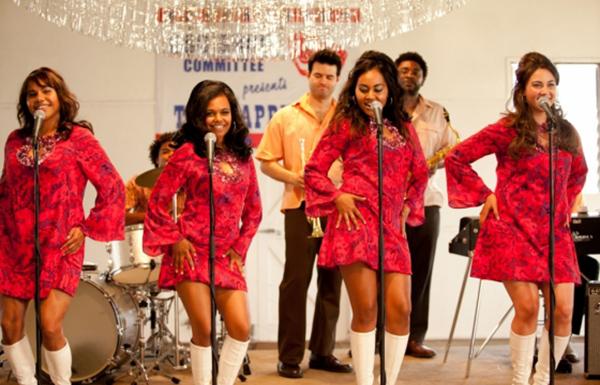By Eisa Ulen Richardson, Indian Country Today Media Network

Too often, movies about brown people devolve very quickly into movies about a single white person surrounded by brown people. It’s not just that a white person is in the film – it’s that a white person becomes the film. The white, usually male, lead overwhelms the narrative, privileging the privileged, and disappointing those of us who paid the price of a ticket and a bucket of popcorn to see ourselves onscreen.
Finally, an unexpectedly delightful story featuring indigenous people has been produced for the big screen. Like magic, this movie does not show us the story through the lens of the white male lead, and so does not distort the image of the four beautiful brown women to whom the story belongs. It does not cater to the fantasy of white people dancing with wolves. Instead, this heartwarming, wonderful, joyous Australian film tells the story of four Aboriginal women from the point-of-view of the women themselves.
The Sapphires is a triumph.
It is also true. In the 1960s, a real-life quartet of sisters and cousins, one of whom had been ripped away from her family as one of the 100,000 Aboriginal children that formed Australia’s “Stolen Generation,” reunited and formed a soul-singing girl group. Styled and billed like The Supremes or The Shirelles of the same era, these women traveled to Vietnam to perform for American troops stationed there during the war.
Based on a hugely successful 2004 stage play of the same name, The Sapphires was written by Tony Briggs, whose mother was the youngest member of the group. The director, Wayne Blair, is also Aboriginal. Chris O’Dowd, who held his own as the good cop that almost got away in the estrogen-packed 2011 hit Bridesmaids, is just as charmingly flawed in The Sapphires. A reluctant manager with a drinking problem and a string of personal and professional misses haunting his heart of gold, O’Dowd’s character transforms into an unlikely hero. He plays the frog that needs a perfectly placed kiss to transform into a scruffy prince.
But the movie, of course, is not about him.
The four women who sing and dance their way through this film also transform. From country western singers who “love Charley Pride” to soul-singing divas who dominate the stage for increasingly larger audiences throughout Vietnam, the women experience a kind of coming-of-age as witnesses to the horrors of war and participants in their own liberation from the racism of mid-20th century Australian society.
Styled in sequins, go-go boots, and miniskirts, these women shine. Their wardrobe expresses their characters’ growing sense of empowerment without positioning them as hyper-sexualized “exotic others.” Though thrilling, their performances do not titillate or play to stereotypes about brown girls and white male access to their bodies. Indeed, their sexuality is expressed in relationships — affirming, sensual relationships, with black men whose romantic gestures are sure to make hearts swoon.
Intimacy grows between O’Dowd’s character and one of the four Sapphires, Gail, the “Mamma Bear” played by Deborah Mailman, who leads the group with loving command that remains unflinching even as the other three women find their own paths to personal power. The friendship and mutual respect expressed by these two characters offers a compelling counter-narrative to the myth of blond, blue-eyed desirability. Rather than detract from the women as the central focus of the film, this relationship only reinforces that focus.
Jessica Mauboy plays Julie, who fights hardest for the chance at something greater than her everyday life. Shari Sebbens plays Kay, the whitest looking of the girls, the one who was stolen, and the one who has the longest journey to make to get back home, and Miranda Tapsell is Cynthia.
Tapsell, whose great grandmother was taken from her family as one of the Stolen Generation, says the authenticity of the film is matched only by the enthusiastic response of the Aboriginal community. The experience of indigenous audiences is unsurprising. From the opening sequence, where four young girls sing in the Aboriginal language of their ancestors to an audience of family and friends, to the final scene, The Sapphires is a film that honors the original people of Australia and life in the missions where they are forced to live.
The Sapphires manages to examine the dispossession of Aboriginal people, the fragmentation of family, cultural dislocation, poverty, the particular plight of women who are also mothers, and the horrors of the Vietnam War — all without losing its upbeat tone, its rhythmic joy, its hopeful expression of uplift. Perhaps because the filmmaker, writer, and four lead actresses are Aboriginal, The Sapphires celebrates the beautiful, flawed, imperfect, glorious humanity of the indigenous people this film showcases.
Aboriginal people, an entire diverse community of the original people of Australia, are on the stage with The Sapphires each and every time they perform, and every round of applause, every cheer, every whistle and shimmy and shake, is for them — for the great-grandmothers who were stolen, and their descendants, the children who grow up to write the stories of their people’s ultimate triumph.
Home, Aboriginal home, though situated on the margins of Australian society, occupies center stage in this glorious film. Grab a batch of tissues, clutch hands with the one you love, and run. Go see it. Go and see yourself.
Read more at http://indiancountrytodaymedianetwork.com/2013/03/15/sapphires-tells-story-aboriginal-supremes-148213
